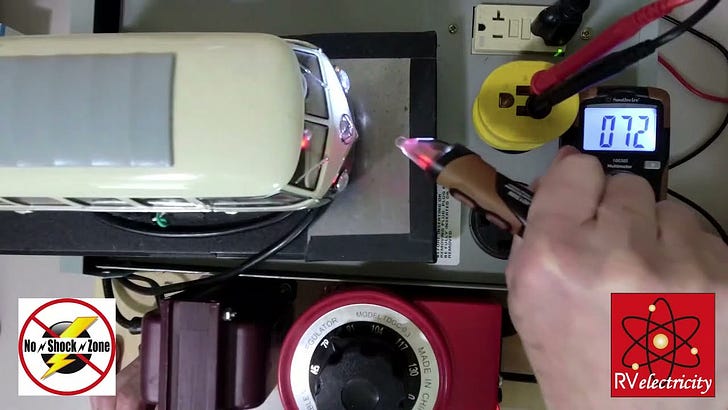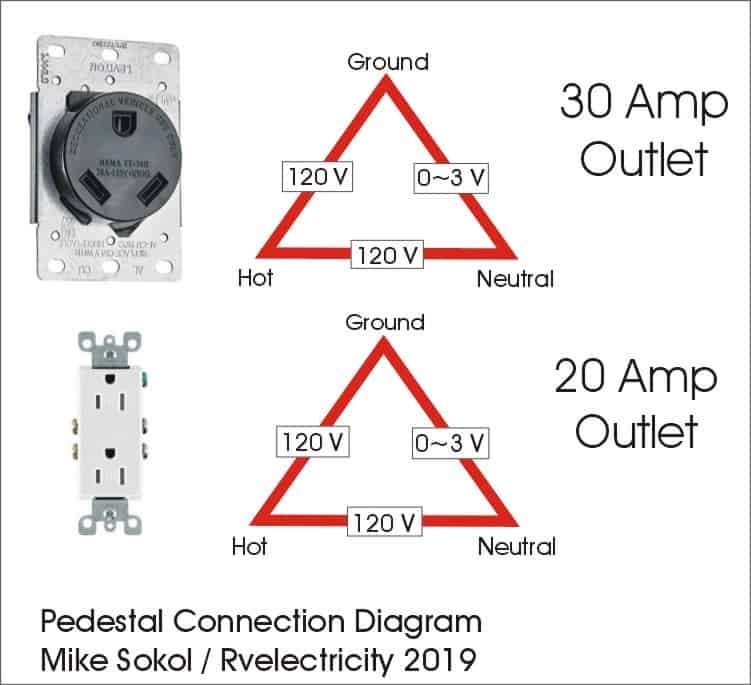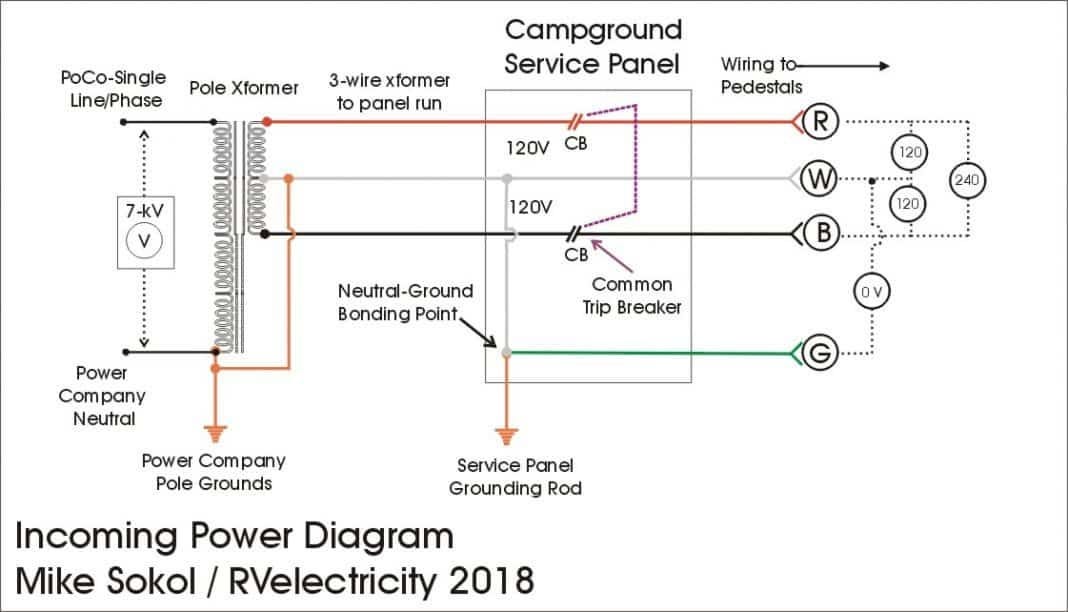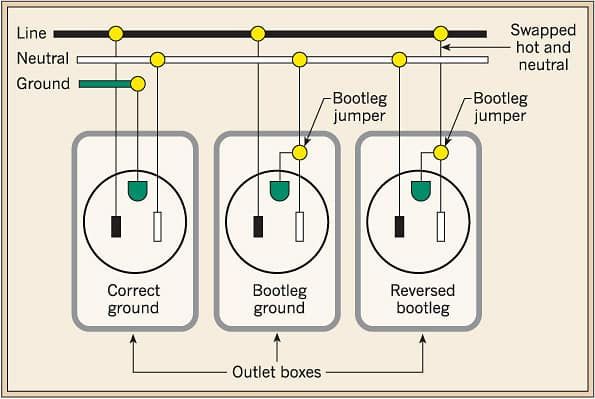Hot-Skin Voltage Confusion
Things That DO NOT Cause A Hot-Skin Shock (and some things that DO)…
From the Forest River Forums
I was staying at my favorite state park this holiday weekend, and when testing the 30 amp outlet using the plug-n-play circuit tester I made from the directions from the myrv.us site...it indicated that the hot and neutral wires were reversed.
I pulled out the multimeter then to verify, and yes it was correct, they were reversed. As the pics show, the normal hot line at the seven o'clock position is reading 0 volts, and the neutral line at the 5 o'clock position is reading 120 volts with both checked with ground. The 20 amp was also reversed but may just been slaved off the 30 amp outlet.
The 50-amp outlet was good, so I just used an adapter and all was good for the weekend. I told the parks maintenance guy (who is an excellent electrician) and he said they just had some contract electric work done. He was fully aware of the problem this can cause along with ground problems in a RV.... and was going to fix it asap. He even told me a story of where one lady had aluminum siding put on her house and they had screwed into a wire (like we hear happening in the RV industry) along with something with her air-conditioner....and she couldn't get back into her house as the door frame was electrified. He also was fully aware that those RV'ers with EMS wouldn't be able to connect to a 30 amp outlet with miswired hot/neutral.
Anyhow, this is another good example of testing all outlets, and reading the good information that Mike Sokol has on his RVelectricity.SubStack.com site.
Here is a link to a great post from Mike that we made a sticky here in the Forest River electrical forums. All RV'ers should know this.
Read the entire Forest Rive Forum post HERE.
Back To Me !
This is Mike Sokol from RVelectricity and the NoShockZone. I just received a private message from the forum moderator that I was needed here, sort of like the Batman Signal, I guess....
OK, let's get to the bottom of this quickly, since a hot-skin voltage is a pretty simple thing that’s often confused, even by electricians. But first, let me detail what is is NOT!!!
It's NOT Caused by Reversed Battery Cables
And you certainly don't want to be swapping battery cables at any time since that really DOES reverse polarity and could easily destroy electronics such as your inverters, televisions, stereo systems, etc... That's because a battery has a positive and a negative pole, so reversing the cables actually reverses the polarity, and electronics are VERY sensitive to polarity reversal and can be destroyed by in in a few milliseconds (a millisecond is 1/1000 of a second).
It's NOT Caused by Reversed AC polarity…
Unless something else is miswired at the same time, a Reverse Polarity doesn’t cause a hot-skin voltage.. Reversed Polarity is loosely defined as the Hot and Neutral wires being swapped or "reversed" in the extension cord or outlet. But the White Neutral wire is supposed to be isolated from the frame/skin of your RV according to the NEC and RVIA build codes.
Things That DO Cause a Hot-Skin Voltage!
If you've accidentally bonded (connected) the Neutral and Chassis Ground together, then it's possible that a Reversed Polarity Outlet with a broken ground wire could energize the RV chassis and skin, but if the ground wires is intact back to the service panel bonding point it will trip the circuit breaker immediately.
A Hot-Ground Causes a 3-Light Tester to Falsely Indicate Reverse Polarity
Just because your 3-Light Tester indicates a Reverse Polarity, it could actually caused by an external hot-ground voltage. Watch this video below to understand it.
What’s an EGC?
It's definitely some sort of compromised EGC (Equipment Grounding Conductor) more commonly called a safety ground, or simply "ground" by most consumers. This "ground" is supposed to drain away any small ground fault currents and trip a circuit breaker for any large ground fault currents.
What’s a Ground Fault?
By definition, a ground fault current is any sort of leakage between the incoming hot wires and the chassis of an appliance or your RV itself. There will ALWAYS be some ground fault current available in ANYTHING plugged into a power outlet, but it's normally very small, typically less than 1 mA (1 milliamp or 1/1000 of an ampere). Most of the time there will be a balancing act between the hot and neutral leakage impedance which the open ground hot-skin voltage biasing to around 1/2 of the line voltage. So if your EGC (ground) wire is compromised without anything else being wrong in your RV, you'll often measure 40 to 80 volts between the RV frame and a screwdriver stuck in the earth.
While this sort of low-current ground fault may not be immediately deadly, you still need to take it seriously since it can turn into a high current ground fault in a heartbeat, and there will be nothing to stop it from killing you or a loved one.
Why Does This Happen?
OK, now let's consider what can compromise your RV's grounding system. There needs to be a solid connection between the frame/chassis of your RV all the way back to the electrical service panel feeding your home or the campground. So everywhere there's a connection, it's possible for a failure to occur.
That means it could be caused a broken or loose or corroded connection in your shore power cable, extension cord, dog-bone adapter, pedestal outlet, or even the AC power feeding the pedestal or outlet itself. I've seen loose grounding screws inside of the RV's circuit breaker box cause this, and even a broken ground screw on the back of the RV's shore power jack on the side of vehicle. To be code compliant, this EGC (ground) needs to have less than 1-ohm impedance back to the service panel's G-N-E bonding point.
A Ground Rod Does NOT "Ground" Your RV!
Lot's of reasons for this, but a ground rod can often measure up to 100 ohms to the earth, so while it might drain away a low-current ground fault, it certainly CAN'T drain away a high-current ground fault. That can be caused by a screw being driven though a wire in the wall, or insulation worn through by rubbing on the frame, or even a failed transformer in your microwave oven. As a side note, jacks on the ground do nothing to "ground" your RV, so don't get me started on that subject.
What’s an RPBG?
Finally, there's one really dangerous outlet mis-wiring condition I sometimes find in old garages and church outlets. I call it an RPBG (Reverse Polarity Bootleg Ground) and it can't be detected by any standard tests including 3-outlet testers or even metering between H-N, H-G and N-G. You must have an external reference to earth to find it. See my article on it at Failures in Outlet Testing Exposed | content from Electrical Construction & Maintenance (EC&M) Magazine and my video on how you can use a NCVT (Non-Contact Voltage Tester) to easily find a hot-skin condition. Watch this video below.
So, please take any felt shocks as a sign that something is seriously wrong with your RV's ground system, which could be anywhere from the outlet itself, dog-bone adapter, extension cord, shore power cord, or even the ground bonding point inside your RV itself.
I get all the police and inspector reports whenever someone is electrocuted (killed) by an RV or guitar on stage, and most every instance was preceded by someone noticing they were feeling a shock for a few days or even weeks. Modern code requires that RVs and appliances are designed so that you NEVER feel a shock. If you do, then the grounding system has failed. It's as simple as that.
Let's play safe out there... Mike Sokol













